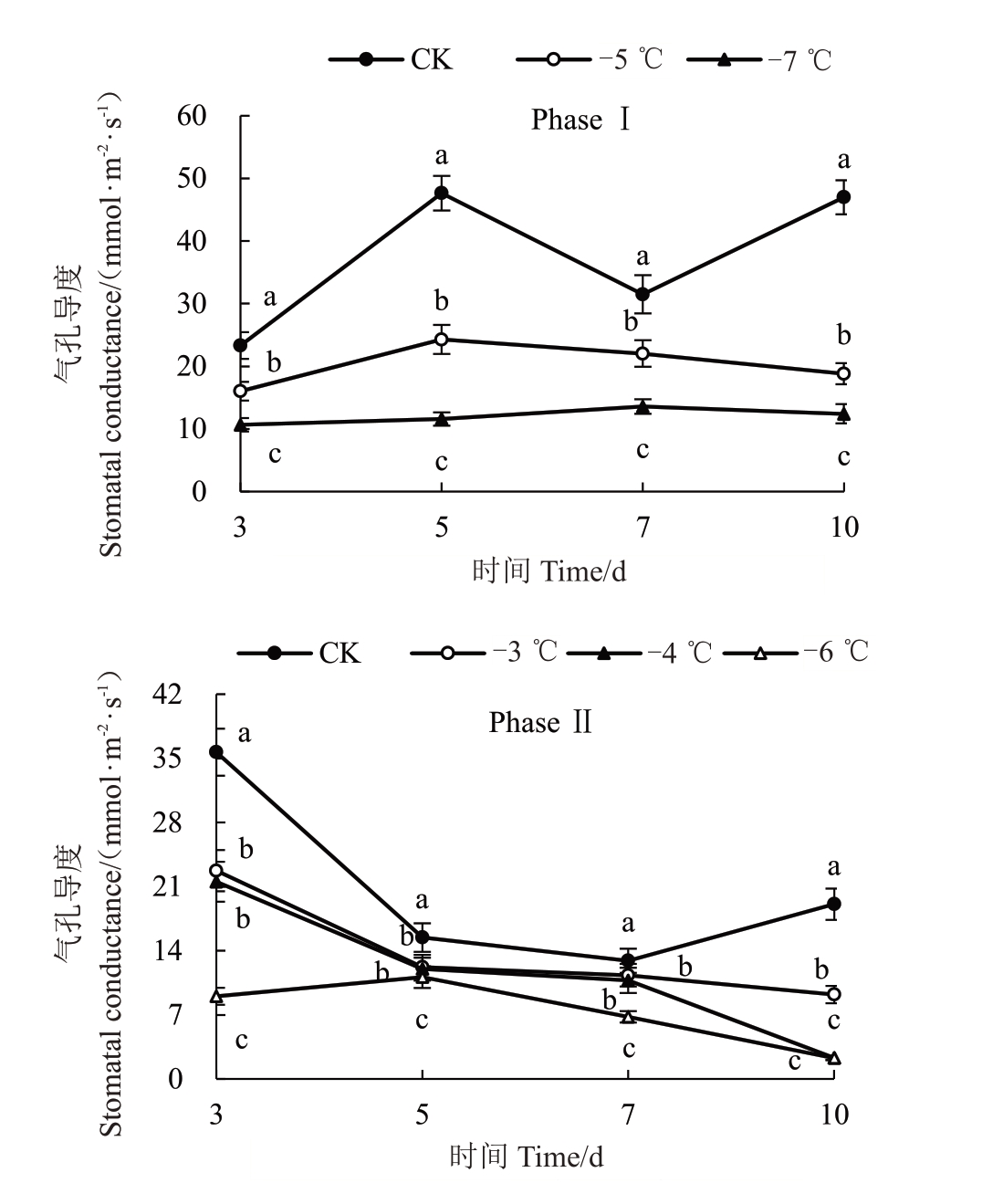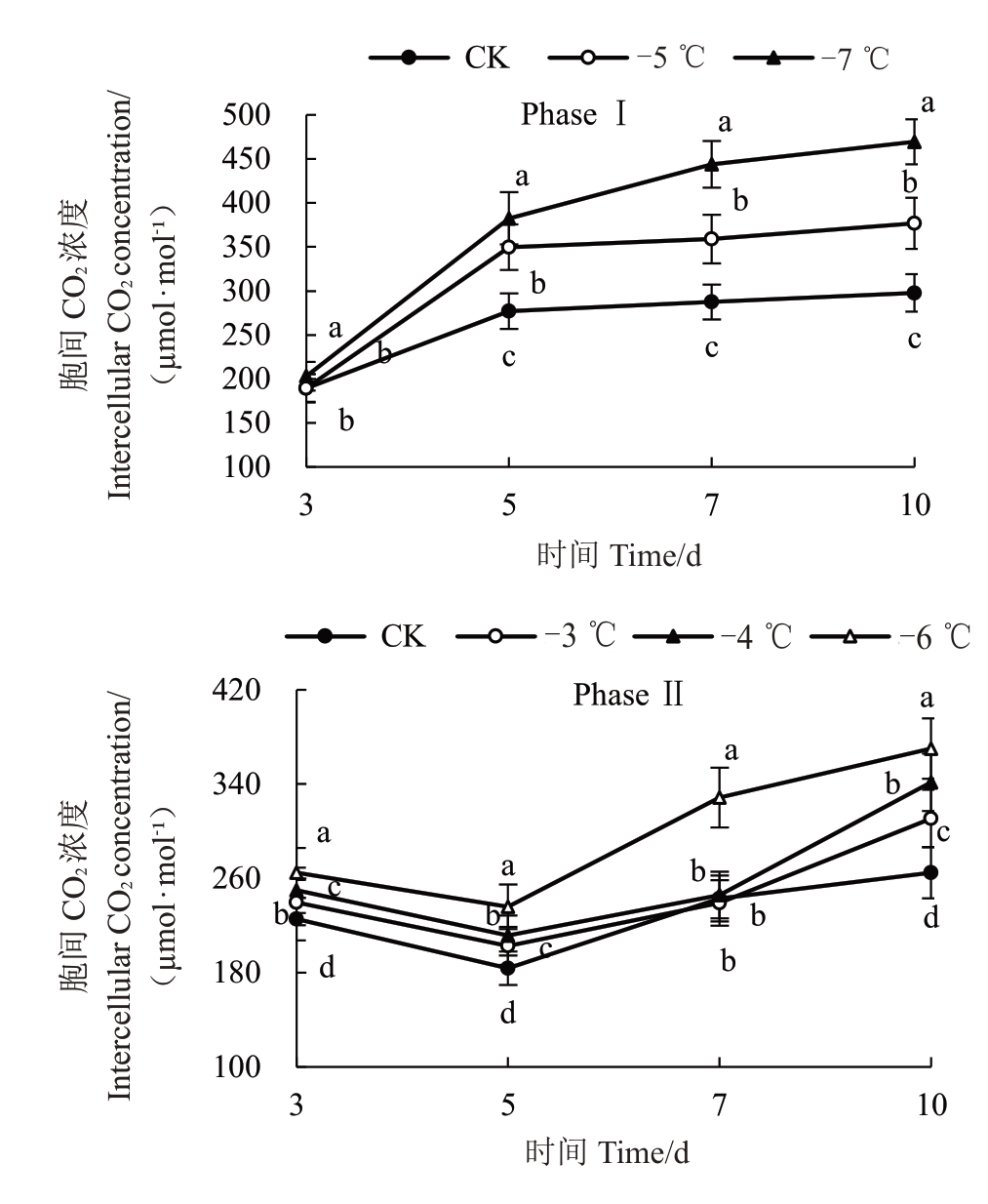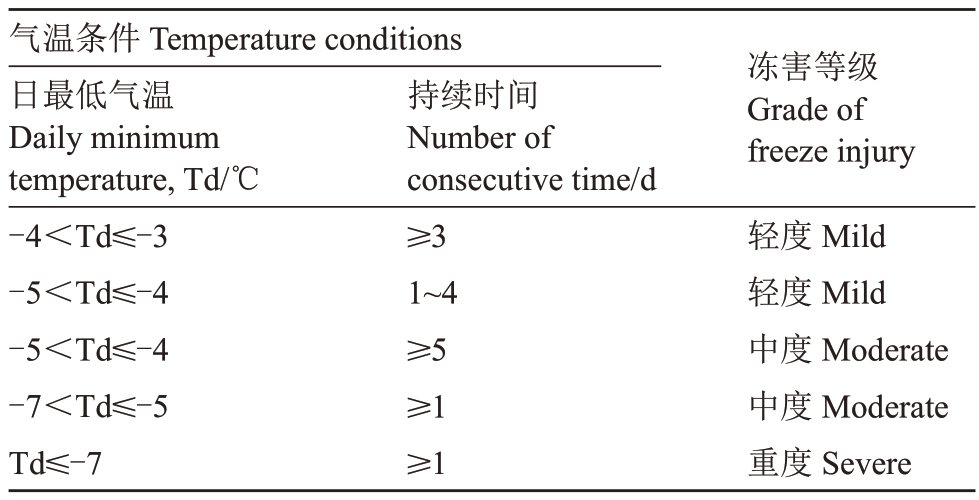脐橙(Citrus sinensis Osbeck)是芸香科柑橘属植物甜橙的一类栽培品种。脐橙是多年生常绿果树,性喜温暖湿润,忌高温和冰(霜)冻,主要种植在热带和亚热带区域。脐橙最早在巴西由甜橙芽变而来,后传入美国并命名为华盛顿脐橙。纽荷尔脐橙是由华盛顿脐橙芽变产生,1978 年引进中国,由于外观漂亮、口感优良、营养丰富,深受消费者青睐。中国是全球最大的纽荷尔脐橙产地,在江西、湖北、湖南、重庆和四川等省(市)广为栽培。
脐橙在一定温度范围内能够正常生长发育,当环境温度低于脐橙生长所需的最低下限温度时,就会造成低温冻害,延缓生长,抑制发育。低温冻害是脐橙生产中最主要的气象灾害之一,主要发生在脐橙越冬期。例如,1999年12月江西出现低温天气过程,赣南极端最低气温普遍在-4~-6 ℃,部分地区达-9 ℃,脐橙遭受大冻害,次年全省脐橙面积和产量均减少一半以上[1]。2009年湖北和江西遭遇持续的低温天气,极端低温达-10 ℃,脐橙出现严重冻害,果园受损,脐橙产量降低[2-3]。1991 年、2005 年、2010 年和2016 年等江西均出现-3 ℃以下极端低温,造成冬季挂果的脐橙落果明显增加[4]。
光合作用是植物生长发育和高产优质的基础,植物90%以上干质量来自叶片的光合作用产物,而光合作用对温度极为敏感[5-6]。柑橘在低温胁迫下,叶绿素含量、光化学效率、电子传递速率和核酮糖-1,5-二磷酸羧化酶/加氧酶(Rubisco)活性降低,光系统Ⅱ反应中心受损或失活,造成光合速率下降[7-8]。低温程度较轻时,植物气孔关闭,气孔导度下降,CO2供应减少,表现为气孔限制;低温程度较重时,植物叶片化学结构破坏,CO2利用率降低,胞间CO2浓度升高,表现为非气孔限制[9-10]。目前,关于不同低温胁迫对脐橙光合性能的影响及发生机制研究鲜有报道。
作物冻害指标及等级标准的制定对低温灾害监测、预警和评估具有重要意义[11-12]。关于柑橘越冬期低温冻害指标研究已有较多报道[13-14]。陈尚模[15]通过柑橘盆栽试验、冻害调查和统计分析等,确定了以日最低气温(Td)为致灾因子的越冬期低温冻害5级等级指标:0级(无冻害)-5 ℃<Td;1级(轻度)-7 ℃<Td≤-5 ℃;2 级(中度)-9 ℃<Td ≤-7 ℃;3 级(重度)-11 ℃<Td≤-9 ℃;4级(严重)Td≤-11 ℃。柑橘低温冻害不仅与低温强度有关,还与降水等气象要素有关[16]。付伟辉等[17]以最低气温和最低气温≤0 ℃天数的乘积,并与11至12月降水距平之和作为柑橘冻害指标。杨爱萍等[18]利用气温、降水及持续时间等,构建了江西省多气象要素的柑橘冻害指标,分单站冻害指数和区域冻害指数,并利用历史柑橘低温冻害实况对其检验;但因指标计算因子的限制,难以直接应用指标对柑橘冻害进行监测、预警和评估。
笔者以纽荷尔脐橙树为材料,利用人工恒温控制箱,开展不同低温处理的果园试验,分析不同低温条件对脐橙光合参数和叶绿素含量的影响,结合形态特征观察,研究脐橙冻害的致灾机制和灾害指标,为柑橘冻害指标制定、防灾减灾和产业发展提供科学支持。
1 材料和方法
1.1 试验材料
试验在江西省赣州市信丰县脐橙气象试验与技术推广示范基地(114°52′E,25°21′N)进行。试验材料为8 年生的纽荷尔脐橙树,砧木也为纽荷尔脐橙植株。果园为向南山坡,坡度约18°;土壤原为偏酸性红壤,经改良后的土壤适宜脐橙生长。果园常规管理,果树生长发育正常。
1.2 试验处理与环境状况
在脐橙越冬期,选取果树大小、长势和结果量一致的植株4 株,在向南方向树腰外围随机选取生长适中、叶片健康的一年生果枝(带3 个果实)进行挂牌,对长势一致的果枝末端叶片系红绳标记。
低温试验分两期独立进行,两期试验分别选择新的独立试验(各2株)树进行,共设计5个温度,分别为-3、-4、-5、-6、-7 ℃。第Ⅰ期试验(-5 ℃、-7 ℃)时间为2020年12月25日至2021年1月4日,第Ⅱ期试验(-3 ℃、-4 ℃、-6 ℃)为2021 年1 月5 日至15日。把挂牌标记的果枝放入便携式人工恒温控制箱(RR-CTC102C,北京雨根科技有限公司),果枝基部穿过温控箱一侧的小孔与脐橙树体连接,采用高度可调的三脚架固定好温控箱后进行低温处理,并逐渐达到设定目标温度。温控箱的规格为42 cm(长)×29 cm(宽)×35 cm(高),温度精度为±0.2 ℃。低温处理时段为夜间23:00—翌日7:00,期间无光照。7:00—23:00 取下温控箱,让果枝自然生长。如此循环,连续处理10 d。两期试验分别以同期同一试验树非低温处理(自然生长)的挂牌果枝作为对照(CK)。每个试验处理2 次重复。试验期间外界的气温资料从果园的自动气象观测站获取。
脐橙的越冬期较长,一般在12 月初至翌年2 月底,其间温度较低,植株生长发育较慢。本试验期间,脐橙均处于相对休眠的越冬期,总体上外界温度普遍较低,其他环境条件较为稳定。图1 为试验期间果园环境温度的变化情况。由图1 可知,第Ⅰ期试验期间外界的日平均气温均值为9.5 ℃,日最低气温平均为4.3 ℃。第Ⅱ期试验期内外界的日平均气温均值为5.8 ℃,日最低气温为1.3 ℃。从图中还可以看出,第Ⅰ期试验处理的第6、7、8 天外界日最低气温低于0 ℃,分别为-0.6 ℃、-2.4 ℃、-2.2 ℃。第Ⅱ期试验处理的第4、7、8 天外界日最低气温较低,分别为-0.7 ℃、-3.7 ℃、-4.0 ℃。另外,2020 年12 月1 日至2021 年2 月28 日期间,除试 验期内和2021年1月19日日最低气温出现-1.0 ℃外,其他时间果园环境未出现日最低气温低于0 ℃的天气。

图1 试验期间果园环境的气温变化
Fig.1 Changes of air temperature in the orchard conditions during the trials
Tave.日平均气温;Tmin.日最低平均气温。
Tave.Daily average temperature;Tmin.Dailyminimumtemperature.
1.3 光合参数测定
于试验处理第3、5、7、10 天的上午10:00,随机选取果枝末端带红绳标记的5 枚叶片,采用光合仪(Li-6800,美国Li-COR公司)测定光合参数,包括净光合速率(Pn)、蒸腾速率(Tr)、气孔导度(Gs)和胞间CO2浓度(Ci)。光合仪设置:进入叶室的气体流速500µmol·s-1,叶室混合扇转速10 000 r·min-1,水分含量(w)50%,温度25 ℃,二氧化碳浓度400µmol·mol-1,光照度1000µmol·m-²·s-1(人工光源)。选择同一试验树非低温处理的一年生果枝叶片进行对照(CK)的同步测定。
1.4 叶绿素含量测定
用SPAD值表示叶绿素含量。测定光合速率的同时,采用SPAD-502叶绿素仪在叶片中部区域,直接测定叶片叶绿素含量,5次重复。
1.5 形态特征观察
试验期间和结束后7 d内,观察和记录对照和处理果实、叶片和枝条的形态特征。
1.6 冻害等级指标及验证
根据脐橙光合速率和形态特征表现,分析脐橙低温冻害的灾害指标。江西省气象局提供典型年份(1991、1999、2009、2021)和典型脐橙种植县(宁都、兴国、于都、安远、会昌、信丰、寻乌)的最低气温资料,根据《江西气候及其影响评价(1991—2010)》报告[19]中有关脐橙灾害记载资料,结合调查的实际灾情等级(0:无;1:轻度;2:中度;3:重度),对比印证冻害等级指标,计算指标验证吻合率。
1.7 数据统计方法
采用Excel 2010 和SPSS 17.0 软件对数据进行统计分析。采用单因素(one-way ANOVA)和最小显著差数法(LSD)进行方差分析(α=0.05)。利用Excel 2010软件作图。图中数据为(平均值±标准差)。
2 结果与分析
2.1 不同低温处理对脐橙光合参数的影响
图2为不同低温处理对脐橙Pn的影响,与CK相比,低温处理均降低了Pn,同一期试验中低温越低,Pn下降越大(图2)。Ⅰ期试验中-5 ℃和-7 ℃处理分别使Pn平均降低61.0%和99.8%,差异均达显著水平(p<0.05);Ⅱ期试验中-3 ℃、-4 ℃和-6 ℃处理分别使Pn 降低9.4%、21.9%和61.1%,且差异均显著(p<0.05)(图3)。说明低温降低了光合速率与呼吸速率的差值,造成光合作用积累的有机物下降,从而抑制了脐橙的生长。

图2 不同低温处理对脐橙净光合速率的影响
Fig.2 Effects of different low temperature treatments on the net photosynthesis rate of navel orange
数据为(平均值±标准差)(n=5)。不同小写字母表示不同处理同一试验时间差异显著(p<0.05)。下同。
The data are shown as the averages of five replicates±standard deviations.Different small letters in the same processing time indicate significant differences among the different treatments (p<0.05).The same below.

图3 不同低温处理下脐橙光合参数降幅的平均变化
Fig.3 Average changes in the decrease amplitude of photosynthetic parameters of navel orange under different low temperature conditions
降幅=(对照-处理)×100/对照。不同小写字母表示同一指标不同低温处理间差异显著(p<0.05)。
Decrease amplitude= (control- treatment) ×100/control.Different small letters indicate significant differences among different low temperature conditions(p<0.05).
不同低温处理对脐橙Tr的影响与Pn相似(图4)。脐橙Tr的平均降幅随温度降低而增加,-3、-4、-5、-6、-7 ℃处理使Tr 分别降低28.9%、38.5%、50.6%、62.5%、69.5%,差异均达显著水平(p<0.05)(图3)。由此可知,蒸腾作用受低温环境的影响较大,低温使叶内导管和气孔受阻,脐橙自身的调节和控制能力下降,生理过程失调,致使Tr下降。

图4 不同低温处理对脐橙蒸腾速率的影响
Fig.4 Effects of different low temperature treatments on the transpiration rate of navel orange
由图5可知,低温处理降低了叶片的Gs,随着低温强度的增加,气孔导度减小明显。-3、-4、-5、-6、-7 ℃处理使Gs分别降低33.2%、43.9%、45.7%、64.9%、67.7%,差异均达显著水平(p<0.05)(图3)。说明低温条件下,叶片与外界进行气体交换变弱,CO2和水汽在大气和叶片内部组织间的传输阻力增加,从而影响了脐橙的光合作用、呼吸作用和蒸腾作用,导致脐橙生长受阻。

图5 不同低温处理对脐橙气孔导度的影响
Fig.5 Effects of different low temperature treatments on the stomatal conductance of navel orange
由图6可知,当采用强度较轻的-3、-4 ℃低温处理且低温持续时间较短时,低温处理的Ci与CK 变化不大;但当采用低温强度较重的-5 ℃以下的低温且低温时间较长时,低温处理的Ci 明显高于CK。-3、-4、-5、-6、-7 ℃处理使Ci分别增加8.2%、14.4%、21.3%、30.8%、42.5%,差异均达显著水平(p<0.05)(图3)。说明较强的低温处理严重破坏了脐橙叶片化学结构,CO2利用率明显下降,此时脐橙受低温冻害较重,叶片的外观形态特征表现为卷曲、萎蔫、甚至干枯死亡。

图6 不同低温处理对脐橙胞间CO2浓度的影响
Fig.6 Effects of different low temperature treatments on the intercellular CO2 concentration of navel orange
总之,不同低温处理对脐橙光合参数的影响相似。与对照相比,低温处理均降低了Pn、Tr和Gs,3个参数的平均降幅随温度降低而增加,Ci的表现与3个参数相反。
2.2 不同低温处理对脐橙叶绿素含量的影响
叶绿素是植物进行光合作用的主要色素,叶绿素的合成及含量影响光能的捕获和CO2 的固定[20]。图7 显示,低温处理均降低了叶绿素含量(SPAD 值),同一期试验中温度越低,SPAD 值的降幅越大。Ⅰ期试验中-5 ℃和-7 ℃处理分别使SPAD 值平均降低3.8%和5.6%,差异均达显著水平(p<0.05);Ⅱ期试验中-3 ℃、-4 ℃和-6 ℃处理分别使SPAD 值降低3.1%、5.6%和9.1%,且差异均显著(p<0.05)。试验结束后7 d,观察到叶片出现卷曲、萎蔫、甚至干枯死亡,说明低温改变了叶绿素合成与降解的速率,使叶绿素含量降低,影响脐橙光合性能。

图7 不同低温处理对脐橙SPAD 值的影响
Fig.7 Effects of different low temperature treatments on the SPAD value of navel orange
2.3 不同低温处理对脐橙形态特征的影响
不同低温条件对脐橙形态特征的影响不同。Ⅰ期CK 在试验期间和结束后7 d 内,日最低气温为-2.0~-2.4 ℃(图1),脐橙果实、叶片和枝条生长正常,未出现低温冻害现象。Ⅱ期CK 在试验期间和结束后7 d内,连续2 d出现日最低气温达-4 ℃的低温天气(图1),造成部分叶片卷曲(表1)。
表1 脐橙冻害程度分级
Table 1 Degree classification of freeze injury of navel orange

气温条件Temperature conditions日最低气温Daily minimum temperature,Td/℃-2~-2.4(Phase Ⅰ-CK)-3~-4(Phase Ⅱ-CK)持续时间Number of consecutive time/d试验结束后7 d脐橙的形态特征Morphological characteristics of navel orange 7 days after the end of the trial果实Fruit正常Normal正常Normal试验第3天净光合速率的降幅Decrease in net photosynthetic rate on the third day of the experiment/%冻害等级Grade of freeze injury-3 2 2≥3斑点水渍状Partially water-stained斑点水渍状Partially water-stained水渍状Water-stained水渍状Water-stained水渍状、脱落Water-stained and shedding水渍状、脱落Water-stained and shedding叶片Leaf正常Normal部分卷曲Partially curled部分卷曲Partially curled枝条Branch正常Normal正常Normal正常Normal 6.53无No轻度Mild轻度Mild-4 1~4卷曲Curly 正常Normal 21.17轻度Mild-4≥5-5≥1部分萎蔫Partially wilting萎蔫Wilting 37.04-6≥1部分干枯Partially dry正常Normal正常Normal部分干枯Partially dry 61.29中度Moderate中度Moderate中度Moderate-7≥1干枯、死亡Dry and die干枯、死亡Dry and die 62.91重度Severe
4 个低温处理(-4、-5、-6、-7 ℃)第1 天和-3 ℃处理第3天,叶片开始出现不同程度的冻伤,温度越低,净光合速率的降幅越大。-4 ℃处理第5天,叶片卷曲程度加重,净光合速率降低13.15%。试验结束后7 d,低温处理的果实出现水渍状,叶片发生卷曲、萎蔫、甚至干枯死亡。低温越低,脐橙受冻的外观形态越严重。其中-6 ℃和-7 ℃处理果实出现水渍状、脱落,-7 ℃处理叶片和枝条出现干枯死亡等现象(图8,表1)。总之,-3 ℃持续3 d 或-4 ℃持续1 d 会减少脐橙的光合产物积累,抑制果实和叶片生长,引起低温冻害。

图8 不同处理(CK、-3 ℃、-5 ℃、-7 ℃)结束后7 d 脐橙的形态特征
Fig.8 Morphological characteristics of navel orange 7 days after the end of different treatments(CK,-3 ℃,-5 ℃,-7 ℃)
2.4 脐橙冻害等级指标及验证
脐橙冻害等级指标:-4 ℃<日最低气温(Td)≤-3 ℃(≥3 d)或-5 ℃<Td≤-4 ℃(1~4 d)属轻度冻害;-5 ℃<Td≤-4 ℃(≥5 d)或-7 ℃<Td≤-5 ℃(≥1 d)属中度冻害;Td≤-7 ℃(≥1 d)为重度冻害(表2)。对典型年份和典型脐橙种植县进行冻害指标验证,发现脐橙冻害指标验证吻合率为83.7%(表3)。
表2 脐橙冻害等级指标
Table 2 Grading index of freeze injury of navel orange

气温条件Temperature conditions日最低气温Daily minimum temperature,Td/℃-4<Td≤-3-5<Td≤-4-5<Td≤-4-7<Td≤-5 Td≤-7持续时间Number of consecutive time/d≥3 1~4≥5≥1≥1冻害等级Grade of freeze injury轻度Mild轻度Mild中度Moderate中度Moderate重度Severe
表3 脐橙冻害指标验证
Table 3 Index verification of freeze injury of navel orange

注:灾害等级划分为0-无;1-轻度;2-中度;3-重度。表中列出了4 个年份和7 个站点所有出现Td≤-3 ℃的情况。若连续1 d 以上出现Td≤-3 ℃,则仅计算1 次冻害情况。
Note:The grading index of freeze injury of navel orange is classified as:0 is no freeze injury;1 is mild injury;2 is moderate injury;3 is severe injury.All occurrences of Td≤-3 ℃in 4 years and 7 stations are listed in the table.If Td≤-3 ℃for more than 1 consecutive day,only one freeze injury is counted.
站名Station日期Date日最低气温Daily minimum temperature,Td/℃按最低气温和持续天数推算等级Grade calculation based on daily minimum temperature and number of consecutive time ①实际灾害等级Actual grade of freeze injury等级对比Grade comparison②-①站名Station日期Date日最低气温Daily minimum temperature,Td/℃按最低气温和持续天数推算等级Grade calculation based on daily minimum temperature and number of consecutive time实际灾害等级Actual grade of freeze injury等级对比Grade comparison②-①宁都Ningdu会昌Huichang兴国Xingguo信丰Xinfeng于都Yudu安远Anyuan 1991-12-28 1991-12-29 1999-12-23 1999-12-24 2009-01-11 2009-01-14 2021-01-01 2021-01-09 2021-01-12 1991-12-28 1991-12-29 1999-12-23 1999-12-24 2009-01-11 2009-01-14 2021-01-01 2021-01-09 2021-01-12 2021-01-13 1991-12-29 1999-12-23 1991-12-28 1999-12-23 1999-12-24 1999-12-25 1999-12-26 2009-01-11 2009-01-14 2009-01-15 2021-01-12 2021-01-13-5.8-7.5-5.9-4.0-4.5-4.0-3.4-4.8-3.7-3.6-6.3-5.3-3.4-4.2-4.3-3.7-5.0-4.3-3.5-5.0-4.5-3.0-6.5-5.5-4.3-3.3-4.2-3.7-3.1-4.2-3.9 3 2 110102 2 11021 2102 10 1②3 2 111112 2 11121 2102 11 1 0 0 001010 0 0010000000 01 00寻乌Xunwu 1991-12-29 1999-12-23 1999-12-24 1999-12-25 1999-12-26 2009-01-10 2009-01-11 2009-01-12 2009-01-14 2009-01-15 2009-01-16 2021-01-01 2021-01-02 2021-01-09 2021-01-12 2021-01-13 1991-12-29 1999-12-23 1999-12-24 2009-01-11 2021-01-12 2021-01-13 1991-12-29 1999-12-23 1999-12-24 1999-12-25 1999-12-26 2009-01-11 2009-01-14 2021-01-12 2021-01-13-5.8-7.0-6.0-4.2-3.5-3.2-5.3-3.8-5.7-4.3-3.1-4.1-4.0-4.8-5.7-5.7-3.8-5.1-3.0-3.4-3.7-4.0-5.0-4.4-5.1-3.8-3.0-5.0-3.8-4.5-5.3①23 2 2 1112 02 01 22 202②23 2 2 1112 12 11 22 212 00 0 0 0000 10 10000 0100
3 讨 论
3.1 低温影响脐橙光合性能
光合作用是植物生长发育的生理基础,同时对低温极为敏感[5,21-23]。低温通过影响光化学效率、电子传递、Rubisco活性、CO2的供应等光合组分影响植物光合作用[7-8,24-25]。不同植物品种的光合参数对低温响应存在差异。17 ℃低温降低了水稻幼穗分化期叶片的Pn、Tr、Gs和Ci,最后导致产量降低[26-27]。5 ℃低温降低了甜瓜的Pn、Gs和Tr[28]。2~3 ℃低温就会降低温州蜜柑的Pn和Gs,提高Ci[8]。-5 ℃低温处理抑制了冬油菜叶片光合作用,Ci升高,Pn和Gs下降[29]。笔者发现,与CK相比,-3 ℃以下的低温处理降低了脐橙Pn、Tr和Gs,3个参数的平均降幅随温度降低而增加,Ci的表现与3个参数相反。-7 ℃处理第7天和第10天的Ci均高于仪器设定的400µmol·mol-1,呼吸速率大于光合速率,Pn出现负值,说明-7 ℃处理对植株的伤害严重。短期低温处理后,植物可逐渐恢复正常生长[10]。文中Ⅱ期CK 在试验期间,连续2 d 出现日最低气温-3℃~-4℃的低温天气,但低温时间较短,冻害较轻,后期观察到脐橙逐渐恢复生长。
低温条件下,光合速率降低的原因包括气孔因素和非气孔因素,如果Gs和Ci同时减小,则Pn下降的主要原因是气孔因素;如果Gs下降,而Ci维持不变甚至上升,则Pn下降是由叶肉细胞结构被破坏、同化能力降低等非气孔因素所致[9-10,30-31]。本文中,低温使Gs下降,Ci上升,表明非气孔限制是导致脐橙叶片Pn下降的主要原因。低温胁迫下,脐橙叶绿体结构受到破坏,叶绿素合成受阻,光合相关酶活性降低,导致光合有机物积累下降[32-34]。本研究表明,-3 ℃以下的低温使叶绿素合成受阻,气孔导度下降,Ci上升,叶肉细胞结构被破坏,蒸腾速率和同化能力下降,导致叶绿素含量下降,CO2和水汽传输受阻,CO2利用率下降,净光合速率和有机物积累降低,这可能是脐橙果实出现水渍状,叶片发生卷曲、萎蔫、甚至干枯死亡的主要原因。由此,可根据光合参数和脐橙形态特征评判脐橙冻害程度。
3.2 脐橙冻害等级指标
陈尚模[15]确定的柑橘低温冻害指标为:-7 ℃<Td≤-5 ℃属轻度;-9 ℃<Td ≤-7 ℃属中度;-11 ℃<Td≤-9 ℃属重度;Td≤-11 ℃属严重。该指标是柑橘大类低温冻害指标,并不完全适用于脐橙。笔者发现,-3 ℃持续3 d或-4 ℃持续1 d会发生脐橙低温冻害。其中-4 ℃<Td≤-3 ℃(≥3 d)或-5 ℃<Td≤-4 ℃(1~4 d)属轻度;-5 ℃<Td≤-4 ℃(≥5 d)或-7 ℃<Td≤-5 ℃(≥1 d)属中度;Td≤-7 ℃(≥1 d)属重度。江西省地方标准《赣南脐橙冻害预警等级》[35]对赣南脐橙冻害气象等级指标划分为:-5 ℃<日最低气温(Td)≤-3 ℃(轻度)、-7 ℃<日Td≤-5 ℃(中度)、Td≤-7 ℃(重度)。这与本研究略有不同,本文得到的脐橙冻害等级指标细化了灾害发生的持续时间,还发现-5 ℃<Td≤-4 ℃(≥5 d)属中度冻害。
笔者仅利用纽荷尔脐橙一年生果枝(带3 个果实),进行连续10 d 的低温处理,开展脐橙光合参数变化分析、机制研究和指标分析。研究表明,不同柑橘果枝(双果枝、单果枝、营养枝)叶片的光合作用也不同[36]。柑橘低温条件下,不同处理天数[9]和品种[37]对光合作用的影响存在差异,低温处理后脐橙的形态表现也有一定的滞后性。此外,生理机制研究还包括渗透调节能力(可溶性糖、可溶性蛋白、脯氨酸含量)和抗氧化能力(SOD、POD、CAT 活性)分析。未来应进行不同低温强度和持续时间的果园试验,加强不同脐橙品种和不同果枝叶片光合参数、渗透调节物和抗氧化酶等对低温的响应研究,为柑橘冻害机制研究、指标制定和防灾减灾提供科学依据。
4 结 论
-3 ℃持续3 d 或-4 ℃持续1 d 会降低脐橙光合产物积累,抑制果实和叶片生长,引起低温冻害。根据日最低气温和持续天数对应的光合速率和形态特征表现,明确了脐橙冻害等级指标,指标验证准确率为83.7%,可为实际生产提供参考。
[1] 赖晓桦,谢上海,邓苏平,杨斌华,赖新生,朱清华.赣南脐橙冻害调查研究及成因分析[J].中国园艺文摘,2010,26(1):141-143.LAI Xiaohua,XIE Shanghai,DENG Suping,YANG Binhua,LAI Xinsheng,ZHU Qinghua.Research and genetic analysis on navel orange frost damage in Gannan[J].Chinese Horticulture Abstracts,2010,26(1):141-143.
[2] 周席华,徐永杰,罗治建,周桂珍,邓先珍,程军勇,陈春芳,傅云,罗友刚,高本望.湖北三峡库区退耕还林区柑橘低温冻害规律调查[J].林业科学,2008,44(11):145-151.ZHOU Xihua,XU Yongjie,LUO Zhijian,ZHOU Guizhen,DENG Xianzhen,CHENG Junyong,CHEN Chunfang,FU Yun,LUO Yougang,GAO Benwang.Characteristics of citrus freeze injury in the newly-reclaimed forest from formland of Three Gorges area in Hubei Province[J].Scientia Silvae Sinicae,2008,44(11):145-151.
[3] 谢远玉,王丽平,钟文勇,廖红玲,赖晓桦.橘园环境条件与脐橙冻害的关系[J].中国南方果树,2010,39(5):36-38.XIE Yuanyu,WANG Liping,ZHONG Wenyong,LIAO Hongling,LAI Xiaohua.The relationship between environmental conditions and freezing injury of navel orange[J].South China Fruits,2010,39(5):36-38.
[4] 姚锋先,郭家乾,管冠,刘桂东,周高峰,钟八莲.晚棱脐橙冬季落果和果实出汁率差异的环境温度因素分析[J].中国南方果树,2017,46(4):14-16.YAO Fengxian,GUO Jiaqi,GUAN Guan,LIU Guidong,ZHOU Gaofeng,ZHONG Balian.Analysis of ambient temperature factors about differences for lane late navel orange winter fruit drop rate and juice rate[J].South China Fruits,2017,46(4):14-16.
[5] 胡美君,郭延平,沈允钢,张良诚.柑橘属光合作用的环境调节[J].应用生态学报,2006,17(3):3535-3540.HU Meijun,GUO Yanping,SHEN Yungang,ZHANG Liangcheng.Environmental regulation of citrus photosynthesis[J].Chinese Journal of Applied Ecology,2006,17(3):3535-3540.
[6] 郜晓峰,刘炜,钟逸云,邢浩,张建琳,常佳楠,孙彬,何培民.不同温度对大叶藻生长与光合生理的影响[J].应用与环境生物学报,2022,28(1):175-181.GAO Xiaofeng,LIU Wei,ZHONG Yiyun,XING Hao,ZHANG Jianlin,CHANG Jianan,SUN Bin,HE Peimin.Effect of different temperatures on the growth and photosynthetic physiology of Zostera marina L.[J].Chinese Journal of Applied&Environmental Biology,2022,28(1):175-181.
[7] 蒋景龙,李丽,赵桦,李新生,沈季雪,徐卫平.低温胁迫对三种柑橘叶片抗性生理特性影响[J].广西植物,2016,36(2):208-215.JIANG Jinglong,LI Li,ZHAO Hua,LI Xinsheng,SHEN Jixue,XU Weiping.Low temperature stress affected physiological characters in three varieties of citrus leaves[J].Guihaia,2016,36(2):208-215.
[8] 郭延平,张良诚,洪双松,沈允钢.温州蜜柑叶片气体交换和叶绿素荧光对低温的响应[J].植物生理学报,2000,26(2):88-94.GUO Yanping,ZHANG Liangcheng,HONG Shuangsong,SHEN Yungang.Responses of gas exchange and chlorophyll fluorescence to different low temperatures in Satsuma Mandarin(Citrus unshiu Marc.)[J].Plant Physiology Journal,2000,26(2):88-94.
[9] 武辉,戴海芳,张巨松,焦晓玲,刘翠,石俊毅,范志超,阿丽艳·肉孜.棉花幼苗叶片光合特性对低温胁迫及恢复处理的响应[J].植物生态学报,2014,38(10):1124-1134.WU Hui,DAI Haifang,ZHANG Jusong,JIAO Xiaoling,LIU Cui,SHI Junyi,FAN Zhichao,Aliyan·Rouzi.Responses of photosynthetic characteristics to low temperature stress and recovery treatment in cotton seedling leaves[J].Chinese Journal of Plant Ecology,2014,38(10):1124-1134.
[10] 邵怡若,许建新,薛立,张柔,吴彩琼,卢广超.低温胁迫时间对4 种幼苗生理生化及光合特性的影响[J].生态学报,2013,33(14):4237-4247.SHAO Yiruo,XU Jianxin,XUE Li,ZHANG Rou,WU Caiqiong,LU Guangchao.Effects of low temperature stress on physiological-biochemical indexes and photosynthetic characteristics of seedlings of four plant species[J].Acta Ecologica Sinica,2013,33(14):4237-4247.
[11] 郭建平.农业气象灾害监测预测技术研究进展[J].应用气象学报,2016,27(5):620-630.GUO Jianping.Research progress on agricultural meteorological disaster monitoring and forecasting[J].Journal of Applied Meteorological Science,2016,27(5):620-630.
[12] 陈惠,杨凯,李政,陈福梓,彭继达,林晶,李丽纯,唐力生,马治国.3 种热带特色果树寒冻害低温等级指标的确定[J].果树学报,2018,35(1):82-93.CHEN Hui,YANG Kai,LI Zheng,CHEN Fuzi,PENG Jida,LIN Jing,LI Lichun,TANG Lisheng,MA zhiguo.Determination of cold and freezing injury grade indexes for three tropical characteristic fruit trees[J].Journal of Fruit Science,2018,35(1):82-93.
[13] 刘宝枢,王元裕,高士贤,周碧英.柑橘冻害温度指标的研究:高山冷冻试验初报[J].中国农业气象,1982,3(2):43-49.LIU Baoshu,WANG Yuanyu,GAO Shixian,ZHOU Biying.Study on indicators of orange freezing injury temperature[J].Chinese Journal of Agrometeorology,1982,3(2):43-49.
[14] 柏秦凤,霍治国,王景红,张勇.中国主要果树气象灾害指标研究进展[J].果树学报,2019,36(9):1229-1243.BO Qinfeng,HUO Zhiguo,WANG Jinghong,ZHANG Yong.Progress in research on meteorological disaster indicators of major fruit trees in China[J].Journal of Fruit Science,2019,36(9):1229-1243.
[15] 陈尚模.试论我国柑橘的越冬低温指标[J].农业气象,1980,8(4):86-90.CHEN Shangmo.On the index of overwintering low temperature of citrus in China[J].Agrometeorological,1980,8(4):86-90.
[16] 周建龙.柑橘冻害的天气气候分析及生产建议[J].气象,1992,18(6):56-57.ZHOU Jianlong.Climate and weather analysis of citrus frozen injury and production suggestions[J].Meteorological,1992,18(6):56-57.
[17] 付伟辉,杨善恭.闽北柑橘冻害和冻害指标的预报[J].气象,1993,19(4):42-43.FU Weihui,YANG Shangong.Prediction of orange freeze injury and its indicators in north of Fujian[J].Meteorological,1993,19(4):42-43.
[18] 杨爱萍,杜筱玲,王保生,郭瑞鸽,刘文英.江西省多气象要素的柑橘冻害指标[J].应用气象学报,2013,24(2):248-256.YANG Aiping,DU Xiaoling,WANG Baosheng,GUO Ruige,LIU Wenying.The multiple-meteorological-factor indexes for orange frozen injury in Jiangxi Province[J].Journal of Applied Meteorological Science,2013,24(2):248-256.
[19] 邓晓明,罗初元,黄莉萍.江西气候及其影响评价(1991—2010)[R].南昌:江西省气象局,2016.DENG Xiaoming LUO Chuyuan,HUANG Liping.Jiangxi climate and its impact assessment(1991—2010)[R].Nanchang:Jiangxi Meteorological Service,2016.
[20] 史典义,刘忠香,金危危.植物叶绿素合成、分解代谢及信号调控[J].遗传,2009,31(7):698-704.SHI Dianyi,LIU Zhongxiang,JIN Weiwei.Biosynthesis,catabolism and related signal regulations of plant chlorophyll[J].Hereditas,2009,31(7):698-704.
[21] BILSKA A,SOWINSKI P.Closure of plasmodesmata in maize(Zea mays) at low temperature:A new mechanism for inhibition of photosynthesis[J].Annals of Botany,2010,106(5):675-686.
[22] 郭延平,张良诚,沈允钢.低温胁迫对温州蜜柑光合作用的影响[J].园艺学报,1998,25(2):111-116.GUO Yanping,ZHANG Liangcheng,SHEN Yungang.Effects of chilling stress on photosynthesis of Satsuma Mandarin (Citrus unshiu Marc.)[J].Acta Horticulturae Sinica,1998,25(2):111-116.
[23] 许永安.低温胁迫对甜瓜幼苗光合能力及叶绿素荧光参数的影响[J].中国瓜菜,2020,33(2):22-26.XU Yong’an.Effects of low-temperature stress on photosynthetic capacity and chlorophyll fluorescence parameters in melon[J].China Cacurbits and Vegetables,2020,33(2):22-26.
[24] SANTINI J,GIANNETTINI J,PAILLY O,HERBETTE S,OLLITRAULT P,BERTI L,FRANÇOIS L.Comparison of photosynthesis and antioxidant performance of several Citrus and Fortunella species (Rutaceae) under natural chilling stress[J].Trees(Berlin),2013,27(1):71-83.
[25] 罗鑫辉,刘明月,黄科,刘玉兵,彭淼,王军伟.不同品种番茄幼苗低温适应性评价及光合特性分析[J].中国瓜菜,2021,34(8):49-55.LUO Xinhui,LIU Mingyue,HUANG Ke,LIU Yubing,PENG Miao,WANG Junwei.Evaluation of low temperature adaptability and analysis of photosynthetic characteristics in different tomato varieties[J].China Cacurbits and Vegetables,2021,34(8):49-55.
[26] 张金恩,聂秋生,李迎春,田俊,王尚明,陆魁东.颖花分化期低温处理对早稻叶片光合能力和产量的影响[J].中国农业气象,2014,35(4):410-416.ZHANG Jin’en,NIE Qiusheng,LI Yingchun,TIAN Jun,WANG Shangming,LU Kuidong.Effects of low temperature stress on the photosynthetic capacity and yield components of early rice at the spikelet differentiation stage[J].Chinese Journal of Agrometeorology,2014,35(4):410-416.
[27] 孙擎,杨再强,高丽娜,殷剑敏,王学林,李伶俐.低温对早稻幼穗分化期叶片生理特性的影响及其与产量的关系[J].中国生态农业学报,2014,22(11):1326-1333.SUN Qing,YANG Zaiqiang,GAO Lina,YIN Jianmin,WANG Xuelin,LI Lingli.Effect of low temperature stress on physiological characteristics of flag leaf and its relationship with grain yield during panicle primordium differentiation stage of early rice[J].Chinese Journal of Eco-Agriculture,2014,22(11):1326-1333.
[28] 吕星光,周梦迪,李敏.低温胁迫对甜瓜嫁接苗及自根苗光合及叶绿素荧光特性的影响[J].植物生理学报,2016,52(3):334-342.LÜ Xingguang,ZHOU Mengdi,LI Min.Effects of low temperature stress on characteristics of photosynthesis and chlorophyll fluorescence in leaves of grafted and own root muskmelon seedlings[J].Plant Physiology Journal,2016,52(3):334-342.
[29] 刘自刚,孙万仓,方彦,李学才,杨宁宁,武军艳,曾秀存,王月.夜间低温对白菜型冬油菜光合机构的影响[J].中国农业科学,2015,48(4):672-682.LIU Zigang,SUN Wancang,FANG Yan,LI Xuecai,YANG Ningning,WU Junyan,ZENG Xiucun,WANG Yue.Effects of low nocturnal temperature on photosynthetic apparatus of winter rapeseed(Brassica campestris L.)[J].Scientia Agricultura Sinica,2015,48(4):672-682.
[30] 梁芳,郑成淑,孙宪芝,王文莉.低温弱光胁迫及恢复对切花菊光合作用和叶绿素荧光参数的影响[J].应用生态学报,2010,21(1):29-35.LIANG Fang,ZHENG Chengshu,SUN Xianzhi,WANG Wenli.Effects of low temperature and weak light stress and its recovery on the photosynthesis and chlorophyll fluorescence parameters of cut flower chrysanthemum[J].Chinese Journal of Applied Ecology,2010,21(1):29-35.
[31] PLOSCHUK E L,BADO LA,SALINAS M,WASSNER D F,WINDAUER L B,INSAUSTI P.Photosynthesis and fluorescence responses of Jatropha curcas to chilling and freezing stress during early vegetative stages[J].Environmental and Experimental Botany,2014,102:18-26.
[32] 赵卫星,刘喜存,李晓慧,徐小利,常高正,梁慎,康利允,高宁宁.甜瓜幼苗对逆境胁迫的生理响应及抗逆性综合评价[J].西南农业学报,2017,30(2):322-326.ZHAO Weixing,LIU Xicun,LI Xiaohui,XU Xiaoli,CHANG Gaozheng,LIANG Shen,KANG Liyun,GAO Ningning.Physiological responses of muskmelon seedlings to different adversity stresses and synthetical evaluation of stress resistance[J].Southwest China Journal of Agricultural Sciences,2017,30(2):322-326.
[33] 杨盛昌,林鹏,中须贺常雄.5 ℃夜间低温对红树幼苗光合速率和蒸腾速率的影响[J].植物研究,2001,21(4):587-591.YANG Shengchang,LIN Peng,NAKASUGA T.Effect of 5 ℃night temperature on photosynthetic rate and transpiration rate of mangrove seedlings[J].Bulletin of Botanical Research,2001,21(4):587-591.
[34] 鲁艳红,廖育林,汤海涛,黄铁平,夏海鳌,李向阳,左光华.不同施氮量对水稻产量、氮素吸收及利用效率的影响[J].农业现代化研究,2010,31(4):479-483.LU Yanhong,LIAO Yulin,TANG Haitao,HUANG Tieping,XIA Haiao,LI Xiangyang,ZUO Guanghua.Effects of nitrogen application on rice yield,nitrogen uptake and use efficiency[J].Research of Agricultural Modernization,2010,31(4):479-483.
[35] 谢银水,谢远玉,张智勇,钟名森,俞文秀,郭鑫宇.江西省地方标准赣南脐橙冻害预警等级:DB36/T860—2015[S].南昌:江西省市场监督管理局,2015.XIE Yinshui,XIE Yuanyu,ZHANG Zhiyong,ZHONG Mingsen,YU Wenxiu,GUO Xinyu.Jiangxi local standards Freeze injury warning level for Gannan navel orange:DB36/ T860—2015[S].Nanchang:Jiangxi Administration for Market Regulation,2015.
[36] 姚珍珍,田喜,潘腾飞,李松伟,简水仙,谢让金,吕强,邓烈.纽荷尔脐橙果实对源叶光合作用的影响[J].中国南方果树,2012,41(2):19-21.YAO Zhenzhen,TIAN Xi,PAN Tenfei,LI Songwei,JIAN Shuixian,XIE Rangjin,LÜ Qiang,DENG Lie.Fruit load affect leaf photosynthesis of Newhall navel orange branches[J].South China Fruits,2012,41(2):19-21.
[37] 邱霞,叶霜,熊博,廖玲,孙国超,荣毅,罗近予,代琳,汪志辉.十三个柑橘品种叶片光合特性研究[J].浙江农业学报,2017,29(6):917-925.QIU Xia,YE Shuang,XIONG Bo,LAIO Ling,SUN Guochao,RONG Yi,LUO Jinyu,DAI Ling,WANG Zhihui.Photosynthetic characteristics of 13 citrus cultivars[J].Acta Agriculturae Zhejiangensis,2017,29(6):917-925.